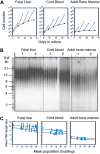Telomeres, stem cells, and hematology
- PMID: 18263784
- PMCID: PMC2234038
- DOI: 10.1182/blood-2007-09-084913
Telomeres, stem cells, and hematology
Abstract
Telomeres are highly dynamic structures that adjust the cellular response to stress and growth stimulation based on previous cell divisions. This critical function is accomplished by progressive telomere shortening and DNA damage responses activated by chromosome ends without sufficient telomere repeats. Repair of critically short telomeres by telomerase or recombination is limited in most somatic cells, and apoptosis or cellular senescence is triggered when too many uncapped telomeres accumulate. The chance of the latter increases as the average telomere length decreases. The average telomere length is set and maintained in cells of the germ line that typically express high levels of telomerase. In somatic cells, the telomere length typically declines with age, posing a barrier to tumor growth but also contributing to loss of cells with age. Loss of (stem) cells via telomere attrition provides strong selection for abnormal cells in which malignant progression is facilitated by genome instability resulting from uncapped telomeres. The critical role of telomeres in cell proliferation and aging is illustrated in patients with 50% of normal telomerase levels resulting from a mutation in one of the telomerase genes. Here, the role of telomeres and telomerase in human biology is reviewed from a personal historical perspective.
Figures




Similar articles
-
Telomeres and aging.Physiol Rev. 2008 Apr;88(2):557-79. doi: 10.1152/physrev.00026.2007. Physiol Rev. 2008. PMID: 18391173 Review.
-
Regulation and Effect of Telomerase and Telomeric Length in Stem Cells.Curr Stem Cell Res Ther. 2021;16(7):809-823. doi: 10.2174/1574888X15666200422104423. Curr Stem Cell Res Ther. 2021. PMID: 32321410 Review.
-
Short telomeres resulting from heritable mutations in the telomerase reverse transcriptase gene predispose for a variety of malignancies.Ann N Y Acad Sci. 2009 Sep;1176:178-90. doi: 10.1111/j.1749-6632.2009.04565.x. Ann N Y Acad Sci. 2009. PMID: 19796246
-
The role of telomeres and telomerase complex in haematological neoplasia: the length of telomeres as a marker of carcinogenesis and prognosis of disease.Prague Med Rep. 2010;111(2):91-105. Prague Med Rep. 2010. PMID: 20653999 Review.
-
Telomeres, telomerase, and hematopoietic stem cell biology.Arch Med Res. 2003 Nov-Dec;34(6):489-95. doi: 10.1016/j.arcmed.2003.07.003. Arch Med Res. 2003. PMID: 14734088 Review.
Cited by
-
Studying the enucleation process, DNA breakdown and telomerase activity of the K562 cell lines during erythroid differentiation in vitro.In Vitro Cell Dev Biol Anim. 2013 Feb;49(2):122-33. doi: 10.1007/s11626-012-9574-0. Epub 2013 Jan 4. In Vitro Cell Dev Biol Anim. 2013. PMID: 23288413
-
Chromosomal and telomeric reprogramming following ES-somatic cell fusion.Chromosoma. 2010 Apr;119(2):167-76. doi: 10.1007/s00412-009-0245-1. Epub 2009 Nov 11. Chromosoma. 2010. PMID: 19904548
-
Telomere Biology and Human Phenotype.Cells. 2019 Jan 19;8(1):73. doi: 10.3390/cells8010073. Cells. 2019. PMID: 30669451 Free PMC article. Review.
-
Quantum dots thermal stability improves simultaneous phenotype-specific telomere length measurement by FISH-flow cytometry.J Immunol Methods. 2009 May 15;344(1):6-14. doi: 10.1016/j.jim.2009.02.004. Epub 2009 Mar 5. J Immunol Methods. 2009. PMID: 19268672 Free PMC article.
-
Modeling of replicative senescence in hematopoietic development.Aging (Albany NY). 2009 Jul 23;1(8):723-32. doi: 10.18632/aging.100072. Aging (Albany NY). 2009. PMID: 20195386 Free PMC article.
References
-
- de Lange T. Shelterin: the protein complex that shapes and safeguards human telomeres. Genes Dev. 2005;19:2100–2110. - PubMed
-
- Stewart SA, Weinberg RA. Telomeres: cancer to human aging. Annu Rev Cell Dev Biol. 2006;22:531–557. - PubMed
-
- Vulliamy T, Dokal I. Dyskeratosis congenita. Semin Hematol. 2006;43:157–166. - PubMed
Publication types
MeSH terms
Substances
Grants and funding
LinkOut - more resources
Full Text Sources
Medical

